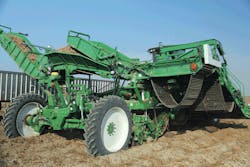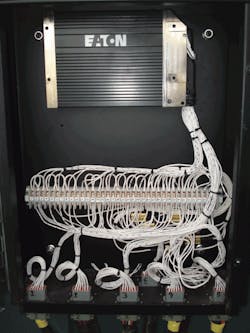Potatoes are harvested by digging them up and separating them from rocks, soil and other field debris. This process makes delivering an unbruised potato a significant challenge, one that has been met and largely overcome by engineers at Advanced Farm Equipment (AFE), Vestaburg, Mich. AFE developed an airhead-type hydraulic potato harvester, which is a sophisticated, self- propelled machine designed specifically to harvest potatoes with an absolute minimum of bruising.
Application challenges
An AFE airhead-type machine is a multifunctional, diesel-powered potato harvesting factory on wheels that has revolutionized the potato harvesting. As the machine advances down a row, potatoes, rocks, earth and other field debris are lifted from the ground and placed on a conveyor. Potatoes are separated from rocks and dirt as they pass under a vacuum that “levitates” the potatoes while allowing the rocks (which are denser than the potatoes) to fall, hence the airhead designation.
“This is a very temperamental operation,” said Greg Merrihew, AFE manager, “that requires fine adjustment to compensate for factors including humidity, wind direction, the size and quantity of rocks in the field, and many other constantly changing conditions. Our original machines used a lot of belts, pulleys, and chains.
“We depended on varying engine speed, or mechanically changing pulleys and sprockets to accommodate changing conditions. They worked very well, and still do, but we are always looking for better ways of doing things. We had a lot of experience with hydraulic fan drives and other sub-systems over the years, so when it came time to upgrade the airhead system, we began seriously looking at an all-hydraulic machine.”
Application solution
For years, DTS Fluid Power, an Eaton distributor in Grand Rapids, Michigan, has been supplying hydraulic components to AFE for the airhead machine and other equipment. DTS engineers worked with Merrihew’s design team to develop an all-hydraulic version of the airhead-type machine. The new version uses the latest technology to deliver higher performance while streamlining the manufacturing process and increasing productivity.
“Eaton is one of the primary proponents of merging hydraulics and sophisticated electronics into integrated electrohydraulic systems,” explained DTS’ Trent Tegg, vice president of sales and marketing. “Eaton offered a single source for nearly all the hardware and software AFE needed to produce a really revolutionary product — everything from the programmable touch-screen display in the cab to the high-performance pumps, motors and valves that make things happen deep in the heart of the beast.
“It’s all tied together with Eaton EFX CAN controllers that communicate with device-mounted electronics via a single CANbus cable. The machine can be preprogrammed to match the user’s exact conditions, and the operator can change functions on the fly as things change.”
Among the advanced hydraulic technologies included in AFE’s upgraded airhead-type machine is a pair of tandem Eaton DuraForce hydrostatic transmissions. A product resulting from an alliance between Eaton and Linde Hydraulics, DuraForce pumps, motors, valve, and transmissions represent the next generation of high efficiency, high-pressure hydraulics. “DuraForce products are a natural choice for this application,” Tegg said. “They are cutting-edge technology based on proven designs that deliver both efficiency and reliability, in a compact package, with great controllability.”
Benefits from results
The switch to an all-hydraulic design controlled via CAN and CANbus wiring has reduced the number of man-hours required to assemble the airhead, while the electronics have greatly enhanced the machine’s capabilities. “Eaton’s CANbus system eliminates a lot of wiring,” Merrihew said, “about 3,000 or 4,000 ft per machine. The plumbing is a lot simpler as well. For example, the electronically controlled pumps only deliver the amount of power that’s needed, so they generate a lot less heat. There is no wasted flow, which greatly reduces fuel consumption and reduces operating costs.
“The machine is a lot more capable now because the operator can adjust virtually everything from the cab. Of course, that also means it’s easier to get into trouble, so we have programmed a lot of failsafe defaults into the system and provided pressure reliefs so things aren’t torn up if a stone gets caught or some other mishap occurs. We have developed pop-up troubleshooting screens that pinpoint any potential hydraulic or electrical problems and have incorporated horsepower management controls so nothing is ever put at risk.”
Perhaps the most important advantage of the new technology is the fact that AFE can monitor and troubleshoot the machines in real time via a cell phone connection or the Internet. In addition, the machines automatically log operating data that is also available for download.
Bill Wesmann is with Eaton’s Hydraulics Group, Eden Prairie, Minn. Contact him at (952) 937-7206, email [email protected], or visit www.eaton.com/hydraulics.
This article was originally published as "Mashed Potatoes not an Option" in the August 2013 issue of Hydraulics & Pneumatics.



